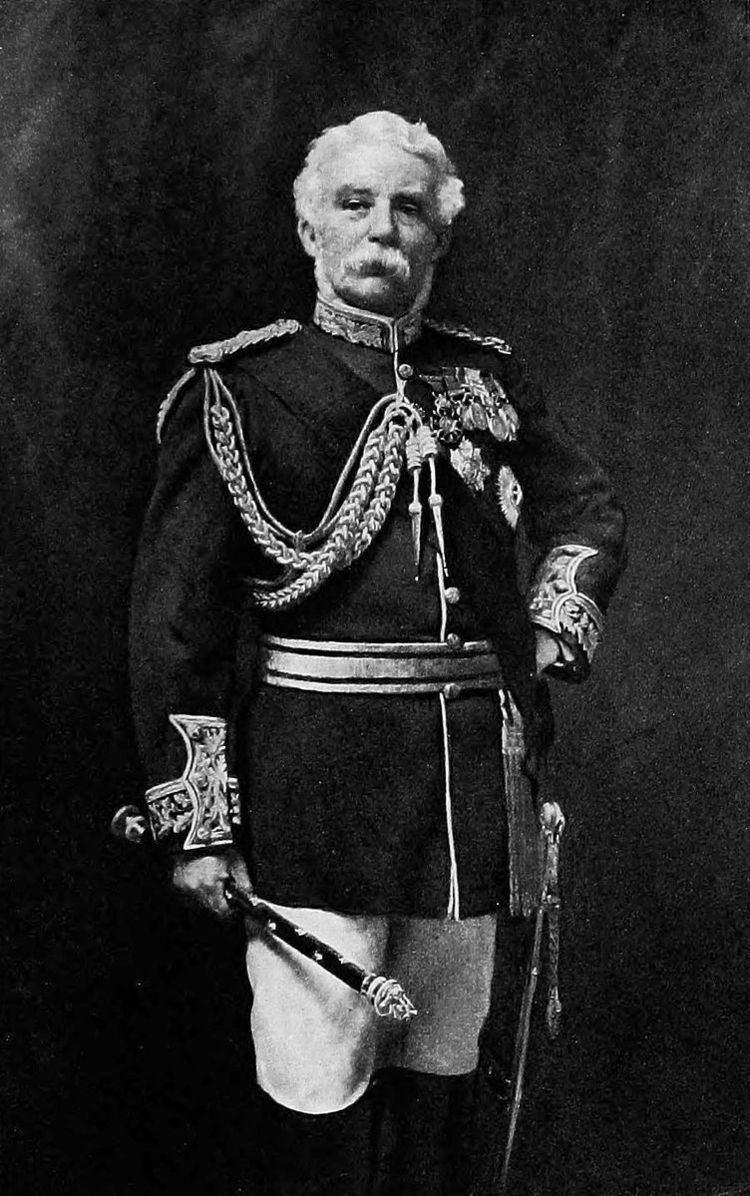Allegiance United Kingdom Rank Field marshal | Name Frederick Haines Years of service 1839–1881 | |
 | ||
Commands held 8th Regiment of FootMysore DivisionMadras ArmyIndian Army Battles/wars First Anglo-Sikh WarSecond Anglo-Sikh WarCrimean WarIndian RebellionSecond Anglo-Afghan War Battles and wars First Anglo-Sikh War, Second Anglo-Sikh War | ||
Field Marshal Sir Frederick Paul Haines (10 August 1819 – 11 June 1909) was a British Army officer. He fought in the First Anglo-Sikh War, in the Second Anglo-Sikh War and then in the Crimean War: during the latter conflict at the Battle of Inkerman, he held an important barrier on the post road guarding the approach to the 2nd Division camp for six hours. He served in India during the Indian Rebellion before becoming Commanding Officer of the 8th Regiment of Foot in the United Kingdom and then Commander of a Brigade in Ireland. He went on to be General Officer Commanding the Mysore Division of the Madras Army and then Quartermaster-General to the Forces in the United Kingdom. He returned to India to become Commander-in-Chief of the Madras Army in May 1871 and then Commander-in-Chief, India in April 1876: he commanded the forces in India during the Second Anglo-Afghan War and successfully argued for a large force being made available before mobilisation occurred, but once the war started the Governor-General of India, Lord Lytton, was inclined to by-pass Haines and deal direct with commanders in the field, causing friction between the two men.
Contents
Military career
Born the son of Gregory Haines, a commissariat officer, and Harriet Haines (née Eldridge), Haines was educated at Midhurst Grammar School and the Royal Military College, Sandhurst before being commissioned into the 4th Regiment of Foot on 21 June 1839. He was promoted to lieutenant on 15 December 1840 and appointed aide-de-camp to General Sir Hugh Gough (his eldest brother's father-in-law) in 1843. Haines took part in the Battle of Mudki in December 1845 and the Battle of Ferozeshah (where he was severely wounded) in December 1845 during the First Anglo-Sikh War. Promoted to captain in the 10th Regiment of Foot on 16 May 1846, he exchanged to the 21st Royal North British Fusiliers on 31 March 1847 and then fought at the Battle of Ramnagar in November 1848, the Battle of Chillianwala in January 1849 and the Battle of Gujrat in February 1849 during the Second Anglo-Sikh War before being promoted to brevet major on 7 June 1849 and to brevet lieutenant colonel on 2 August 1850.
Haines served in the Crimean War taking part in the Battle of Alma in September 1854, the Battle of Balaclava in October 1854 and the Battle of Inkerman in November 1854, where as the senior officer, he held an important barrier on the post road guarding the approach to the 2nd Division camp for six hours.
Returning to England, Haines became assistant adjutant-general at Aldershot Command in February 1855 and, having been promoted to the substantive rank of lieutenant colonel on 24 April 1855 and to brevet colonel on 18 December 1855, he became military secretary to the Commander-in-Chief, Madras Army in India in June 1856 retaining that role through the Indian Rebellion in 1857. He became Commanding Officer of the 8th Regiment of Foot in the United Kingdom in October 1859 and Deputy Adjutant-General in Ireland in June 1862 before being given command of a brigade in Ireland with the temporary rank of brigadier-general in March 1864.
Promoted to brevet major-general on 25 November 1864, Haines returned to India to become General Officer Commanding the Mysore Division of the Madras Army in March 1865. He went on to be Quartermaster-General to the Forces in the United Kingdom in 1870 before returning to India again to be Commander-in-Chief of the Madras Army as well as a member of the Council of the Governor of Madras with the local rank of lieutenant general in May 1871.
Promoted to the substantive rank of lieutenant general on 23 May 1873 and to the local rank of full general on 22 March 1876, Haines became Commander-in-Chief, India in April 1876, with promotion to brevet full general on 1 October 1877. He commanded the forces in India during the Second Anglo-Afghan War and successfully argued for a large force being made available before mobilisation occurred, but once the war started the Governor-General of India, Lord Lytton, was inclined to by-pass Haines and deal direct with commanders in the field, causing friction between the two men. Haines was offered a baronetcy for services to HM Government in India in 1880 but declined the honour due to his wife's failing health, presuming that it would be re-offered to him after her recovery. However, her health declined and she eventually died and the offer of the baronetcy was never renewed.
Returning to retirement in London in 1881, Haines was promoted to Field Marshal on 21 May 1890. He also became colonel of the 104th Bengal Fusiliers, subsequently of the 2nd Battalion of the Royal Munster Fusiliers and then of the Royal Scots Fusiliers. He died at his home at Pall Mall in London on 11 June 1909 and was buried in Brompton Cemetery, London.
Family
In 1856 Haines married Charlotte Jane Sophia Miller and together they went on to have three sons.
Honours
Haines' honours included:
